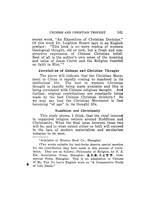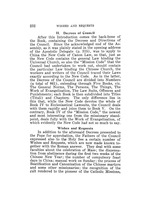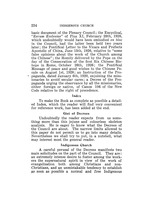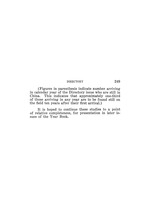|
|
|
Your search within this document for 'book' resulted in 62 matching pages.
|
| 1 |
 |
Page i
“...THE CHINA CHRISTIAN
YEAR BOOK
1929
(Sixteenth issue of the China "Mission" Year Book)
Issued under arrangement between the Christian
Literature Society for China and the National
Christian Council of China under the direction of the
following Editorial Board appointed by the National
Christian Council.
Mr. E. E. Barnett Rev. Edwin Marx
Rev. T. C. Brown Dr. J. L. Maxwell '
Rev. L. D. Cio Rev. F. R. Millican
Miss M. Frame Mr. John Nipps
Miss L. K. Haass Dr. Frank Rawlinson
Dr. C. L. Hsia Rev. Stanley Smith
Dr. Herman Liu Mr. H. C. Tsao
Rev. E. C. LobenstineMiss K. Vaughn
Dr. D. MacGillivray Rev. Z. K. Zia
Editor
Rev. Frank Rawlinson, D.D.
Editor, Chinese Recorder.
Shanghai
i
Christian Literature Society
1929. \...”
|
|
| 2 |
 |
Page ii
“...ii
preface
It is somewhat more than a year since the last
China Christian Year Book appeared. The present
issue has been delayed by the extreme difficulty
involved in laying upon busy people the task of writing
for it. All the chapters in this volume are voluntarily
contributed by those who have, of necessity, felt the
task of writing them one of extra and mostly heavy
pressure. This explains why the chapter on "Govern-
ment Education, 1928-29," is found at the end of the
volume instead, of in the section under "Education
and Students," where it strictly belongs. The Editor
and the Editorial Board wish, therefore, to express
their sincere appreciation to all who have helped make
up this annual. Without this free and willing help
it would be impossible to issue it.
Of necessity a considerable proportion of the
material in this volume will be past history when it
is read. This is due in part to the unavoidable delay
in publication mentioned above, but in much larger
part it is the result...”
|
|
| 3 |
 |
Page iii
“...That is as it should be! Some of these writers have
done masterly research work in order to make their
contribution to this Year Book: all of them have
written out of a rich experience; a few of them make
bold attempts to indicate roads to progress newer than*
those already opened up. This volume reveals that
Chinese leaders are delving deeply into the intricate
problems challenging them. Such determined study
is bound to result in the finding of worthwhile solutions
thereto. This volume, furthermore, reveals no atti-
tude of laisez-faire in those responsible for the future
of the Nation and the Church. Quite the contrary!
A determination to measure and master the problem
of reconstructing China is their major driving force.
Statistical information is somewhat more promin-
ent in this issue of the Year Book than in the last.
This, however, appears mainly in estimates of pro-
jected economic reforms. In connection with present
and actual situations it is much less in evidence. The
difficulty...”
|
|
| 4 |
 |
Page 32
“...their policy abundantly clear
and have taken such practical steps as lay in theSri
power to carry it into effect."
France and Italy
France and Italy followed suit and signed, on
October 17, agreements respectively, for the settle-
ment of the same Incident. The Joint Commissions
provided for in these settlements have been dr1
stituted and some of them have already presented
their reports.
Tsinan Incident
The Tsinan Incident of May 1928, is probably
fresh in the minds of all readers of the Year Book-
As a result thereof, the feelings between the people
of China and Japan have been greatly strained. For-
tunately the major differences involved in this Incident
have recently been smoothed out. In the agreement
of March 28, 1929, both governments deplored the
unhappy incident and Japan agreed to withdraw her
troops from Shantung within two months. A Sino-
Japanese Joint Commission is to be set up for the
investigation and adjudgment of the question of losses
sustained by the nationals of both...”
|
|
| 5 |
 |
Page 121
“...118
SCIENCE AND DEMOCRACY
fully one year, and when the debates were finally col-
lected and published in book form in 1924, the whole
book contained over 250,000 words. Both Mr. Wu
Ch-ih-hui and I, needless to say, were allied with Mr.
V. K. Ting in the controversy.
Spirituality of Science and Democracy
In 1926, I published my essay "On our Attitude
Towards the Modern Western Civilization/' which
appeared simultaneously in the Japanese monthly
Kaizo and in the Chinese weekly Contemporary
Review. The substance of this essay was rewritten
in English as a chapter in Professor Charles A.
Beard's Whither Mankind, which came out in 1928.
In this essay I took the stand that China must whole-
heartedly accept modern civilization especially science,
technology and democracy. I tried to show that
there was very little spirituality in the civilization
which had tolerated such a brutal custom as foot-
binding for a thousand years without a protest. 1
also pointed that science and the religion of democracy...”
|
|
| 6 |
 |
Page 125
“...*
PART II
RELIGIOUS THOUGHT
CHAPTER VI
recent developments in religious thought
F. R. Millican.
Re-evaluation
The loosening of the grip of old convictions and
habits of thought invariably results in an effort to-
wards re-evaluation and restatement in the light of
current thought. In an article entitled "Philosophical
and Religious Thought" in the 1926 Year Book was
set forth in brief summary the results of a study of
such a re-evaluation in present-day China. This ar-
ticle will present further material, more particularly,
on the developments in religious thought. We shall
find efforts within various religious groups to clarify
their own teachings, as well as attempts to correlate
these with the teachings of other groups.
Buddhism
Let us begin with Buddhism. Buddhism is being
put forward more and more as an all-inclusive religious
system adapted to the needs and the aspirations of
all types of minds throughout the world. This move-
ment involves, on the one hand, an effort to fit all the...”
|
|
| 7 |
 |
Page 126
“...BUDDHIST SECTS
12&
Tai Hsii
Tai Hsu, who has recently returned from a lecture-
tour in Europe in the interest of the world-wide pro-
pagation of Buddhism, has been lecturing and writing
quite extensively. Within recent years he has pub-
lished several volumes giving the results of his studies.
Two of these were listed in the Year Book for 1926 in
the article on "Philosophical and Religious Thought."
A more recent volume is called "An Introduction to the
Study of the Sects of Mahayana Buddhism (^c HI ^
m Si tr).*
Buddhist Sects
In this latter volume we find a brief summary
of the teachings of the various Buddhist sects, as well,
as a comparison of their teachings with each other. It:
will not be possible to take the reader through the
maze of metaphysical discussion that we find in this
volume. A few brief references must suffice for our
present purpose. Starting wTith the Hwa Yen Ching
we are given by Tai Hsii the following
general division of the all that is included in our
phenomenal...”
|
|
| 8 |
 |
Page 127
“...124
REFORM IN BUDDHISM
Pure Land Sect
Farther on in the book we find a chapter on the
Pure Land Sect. It is pointed out that, since few
men have either the time or patience to delve into the
intricacies of classical discussions or to engage in pro-
longed meditation in order to become "enlightened/'
an Easy Way is provided for the masses. This Easy
Way, as opposed to the Difficult Way of the Ch'an, or
Meditation, is the way of salvation by faith in Amidha,
the Goddess of Mercy, and other saviours. This sal-
vation' brings immediate entrance into the Western
Paradise. While this is not the final goal, or Nirvana,
yet it is a big jump in that direction. It is of special
interest here to note that Tai Hsu, who is himself a
longstanding devotee of the Meditation cult, states in
this chapter that "This Easy Way, inasmuch as it lifts
men from this world directly into Paradise, holds the
highest place among all the Buddhist Ways." This
is in accord with his effort to make Buddhism a com-
prehensive...”
|
|
| 9 |
 |
Page 129
“...Buddhism as found in its temple life, and to propagate
the teachings of the Pure Land. To this end he car-
ries on an extensive correspondence and devotes muck
time to writing books. He has recently published a
set of four volumes in defence of, and in explanation
of, the way of salvation by faith in the Buddhist
saviours.f He has also more recently published a
* Referred to in Pratt's, "Pilgrimage of Buddhism" in a.
footnote on Page 388 as Yung Kuang.
t( EP % & AT X ) Vols. 1-4. For sale in Buddhist Book
Stores....”
|
|
| 10 |
 |
Page 134
“...spirit of Confucianism in his "Three Principles." And
it is interesting to note that the motto of the Nation-
alist Movement is drawn from one of the finest por-
tions in Confucian, in fact in all, literature. It sounds
like the voice of one of the prophets, and shows the
vision of a Tennyson. In view of the prominence
given this passage and because of its intrinsic worth
we venture to give it in full. It is found in the Li
Yun P'ien of the Book of Rites (| jjig where
a contrast is drawn between a society that rests on
*( fjii&Sf Sold by Mission Book Co., Shanghai....”
|
|
| 11 |
 |
Page 135
“...The latter phrase, "all under heaven will work for the
common good," has been variously interpreted and
greatly abused. Paul Linebarger in his "Sun Yat-sen
and Chinese Republic" (p. 37) translates it as "All
nations shall be the opposite of selfishness," or "Brot-
herhood of all nations." The Communists and those
who wished to confiscate any property that did not be-
long to them were inclined to translate it, "The world
*See Page 8 of Dr. R. Y. Lo's "The Social Philosophy of
Confucius." Mission Book Co., Shanghai....”
|
|
| 12 |
 |
Page 143
“...truths concerning
God, sin, salvation, and the person and work of Christ.
Mr. Chao is fearless in his approach and gives his
critics and doubters in general ample opportunity to
set forth their views. And then he brings in his own
statements of the Christian philosophy and conviction.
A further contribution to the exposition of Christian
doctrine and one which shows broad study and some
originality is given by Peter Peng of Peking in his *
*See article in issue of June, 1928.
f Available at Mission Book Co., Shanghai....”
|
|
| 13 |
 |
Page 144
“...CHINESE AND CHRISTIAN THOUGHT 141
recent work, "An Exposition of Christian Doctrine."
Of this work Dr. Leighton Stuart says in an English
preface: "This book is no mere replica of western
theological thought, old or new, but a fresh and con-
structive expression of Chinese Christian belief.
Best of all is the author's own sense of the meaning
and value of Jesus Christ and; the Religion founded
on faith in Him."*
Correlation of Chinese and Christian Thought
The above will indicate that the Christian Move-
ment in China is rapidly coming to manhood in its
intellectual life. The best in western Christian
thought is rapidly being made available and this is
being correlated with Chinese religious thought. And
further, original contributions are constantly being
made by the best Chinese Christian thinkers.f So
we may say that the Christian Movement is fast
becoming "of age" in its thought life.
Buddhism and Christianity
This study shows, I think, that the chief interest
in organized religion...”
|
|
| 14 |
 |
Page 184
“...business borrows $2000,
proceeds to fail, and then sets up the same kind of
trade; in another part of the city, daring his wealthy
patron to go to law to secure his rights; and the patron
simply recognizes that he has no recourse in law, as
for a rich man to su'e a poor one is practically attack-
ing himself. Thus the cheat who is poor, feels secure
and presumes on 'his immunity as never before.
Again a head clerk in a bookstore takes on concubines*
or diverts the monies to a rug business, until the ^book-
store-goes bankrupt; but he feels unashamed and' does
not even take the trouble to flee. The head of a coun-
try district appropriates the funds designated for a
public debt without any apparent effort to cover the
theft, defying his fellow headmen and the country
magistrate and not even offering them a share. In
such cases the first retort of the accused is, "If you
want to go to law do so;" whereas formerly the first
first word of the accuser .would be a threat to go to
law.
Graft
Graft on...”
|
|
| 15 |
 |
Page 223
“...220
WESTERN CO-OPERATION
into politics rather than enter the ministry. As for
women, educational work is more preferable."
The reasons given are that "the progra'm of the
church does not appeal to them. Denominational dif-
ferences and arrogance on the part of older workers
prevent them. Remuneration is so meagre that they
can meet neither the educational expenses of their
children nor provide for old age. Book knowledge is
too much emphasized in their education, so that re-
ligion and life are for them two separate things. Re-
ligious education in schools is inadequate, so that the
youth leaves school with no substantiated faith or
thorough understanding of Christianity."
The conferences were marked throughout by an
eager desire on the part of delegates not only to find
out what Christians in other groups were thinking and
to share their own thinking with them, but also to face
the future together courageously and to see how the
different Christian forces, separated as they are into so...”
|
|
| 16 |
 |
Page 233
“...230
decrees approved
since he may now know what happened in that mem-
orable Assembly.
We have been kindly asked by the Editor of The
China Christian Year Book to give a comprehensive
insight, into this most important document, to the
English speaking reader, who does not handle Latin,
the official language of the Church and consequently of
the Chinese Council. Such a request bears an elo-
quent testimony to the interest that non-Catholic
authors and readers take in things Catholic. In order
to comply with this legitimate wish, we intend to
give in this paper:
I. A skeleton analysis of the contents of this
Book;
II. A comprehensive synopsis of the Decrees of
the Council.
I. Book of Decrees
The Book contains:
(1) The Acts which preceded, accompanied and
followed the Council (pp. 1-20).'
(2) The Decrees and Directions of the First
Chinese Council (pp. 21-260).
(3) The Wishes and Requests of the Council
(pp. 261-284).
(4) An Instruction of the Propaganda on Mat-
rimonial Causes in China (pp...”
|
|
| 17 |
 |
Page 235
“...Introduction comes the back-bone of
the Book, containing the Decrees and Directions of
the Council. Since the acknowledged end' of the As-
sembly, as it was plainly stated in the opening address
of the Apostolic Delegate (p. 315), was to apply to
China the New Code of Canon Law, so that, just as
the New Code contains the general Law binding the
Universal Church, so also the "Mission Code" that the
Council had undertaken to work out, should contain
the particular Law binding the Chinese Church, the
workers and writers of the Council traced their Laws
exactly according to the New Code. As in the latter,
the Decrees of the Council are divided into Numbers
(a total of 861), extending through Five Books, viz.
The General Norms, The Persons, The Things, The
Work of Evangelization, The Law Suits, Offences and
Punishments; each Book is then subdivided into Titles
(Tituli) and Chapters. The only difference lies in
this that, while the New Code devotes the whole of
Book IV to Ecclesiastical Lawsuits, the...”
|
|
| 18 |
 |
Page 237
“...by the Pope on the
day of the Consecration of the first Six Chinese Bis-
hops in Rome, October 26th, 1926; the Pontifical
Message of peace and good wishes to the Chinese Pe-
ople on August 1st, 1928; an Instruction of the Pro-
paganda, dated January 6th, 1920, enjoining the miss-
ionaries to avoid secular cares; a Decree of the Pro-
paganda urging the observance by all the missionaries,
either foreign or native, of Canon 106 of the New
Code relative to the right of precedence.
Index
To make the Book as complete as possible a detail-
ed Index, which the reader will find very convenient
for reference work, has been added at the end.
Gist of Decrees
Undoubtedly the reader expects from us some-
thing more than this jejune and' colourless skeleton
analysis. He is eager to know what the Decrees of
the Council are about. The narrow limits allowed to
this paper do not permit us to go into many details.
Nevertheless we shall try to put, in a nutshell, what
may interest most the general reader.
Indigenous...”
|
|
| 19 |
 |
Page 245
“...242
MAIN AIMS
elegant but readable Chinese (35-38). The third
which met in Shanghai in April last, will work for the
unification of a prayer book and of a triple Catechism,
small, medium and large (39-48).
Two Main Aims
This rapidtoo rapidbird's-eye view of the
Chinese Plenary Council, full of so many interesting
questions for the future of the Catholic Church in
China, abundantly demonstrates, we think, what we
announced above, viz. that the Council had two main
solicitudes: to foster the supernatural spirit in view
of the work of evangelization and to establish an in-
digenous church. And be it so. God grant that the
tiny mustard seed planted once by the children of the
Assisian Francis, replanted later on by the brethren
of another Francis, the Xaverian, irrigated ever since
with the tears, sweat and blood of so many mission-
aries hailing from all parts of the world, may, thanks
to the First Plenary Council, spring forth in the near
future into a magnificent tree, whose roots will be...”
|
|
| 20 |
 |
Page 252
“...DIRECTORY
249
(Figures in parenthesis indicate number arriving
in calendar year of the Directory issue who are still in
China. This indicates that approximately one-third
of those arriving in any year are to be found still on
the field' ten years after their first arrival.)
It is hoped to continue these studies to a point
of relative completeness, for presentation in later is-
sues of the Year Book....”
|
|
|